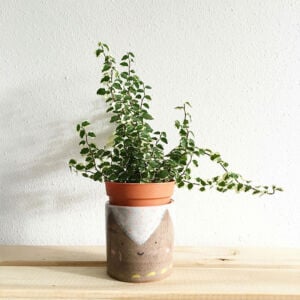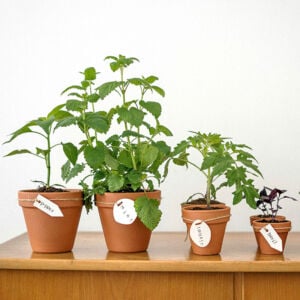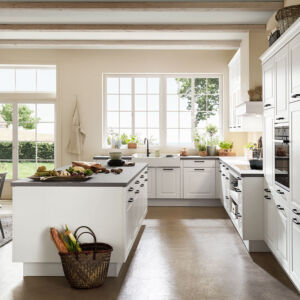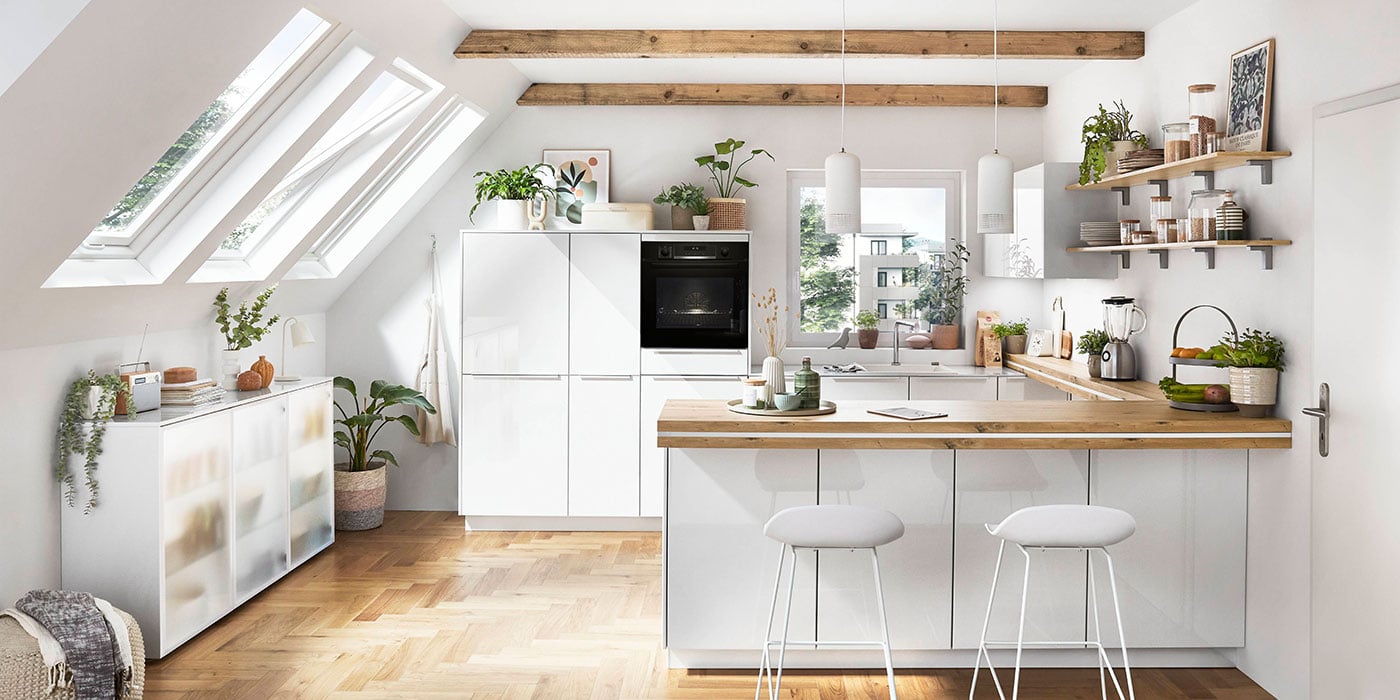When you picture your dream kitchen, what do you see? Sleek cabinetry, beautiful lighting, thoughtfully chosen surfaces… but for me, it’s the houseplants that bring it to life. You’ll always find my kitchen designs peppered with leafy green friends — perched on windowsills, cascading from shelves, or tucked into little nooks on countertops. There’s something about bringing nature indoors that completes a space, especially in the kitchen, where we begin mornings, prepare nourishing food, and gather at the heart of our homes.
Adding greenery to the kitchen isn’t just a style choice (although it certainly is a gorgeous one) — it’s a wellbeing boost, a mood-lifter, and even a tiny nod to sustainability. Whether you’re a full-on plant parent or a tentative beginner, this blog explores why I believe no kitchen is truly finished without a little foliage.
Greenery & Wellbeing: More Than Just Pretty
Let’s start with the feel-good side of things. Plants have been proven to help reduce stress and anxiety, and boost focus — which can be handy whether you’re cooking a new recipe, managing family chaos, or just trying to enjoy your first coffee of the day.
Psychologists have long explored the concept of biophilia, the human tendency to seek a connection with nature. When we surround ourselves with natural elements — like timber textures, soft lighting, and of course, plants — we feel more grounded, calmer, and more connected to the rhythm of the natural world. And in spaces like the kitchen, where utility can sometimes take centre stage, that grounding effect is especially welcome.
Even a single potted plant on a shelf can shift the tone of the space. Suddenly, the kitchen feels more welcoming, less clinical, and far more lived-in.

Colour Palettes and Plant Pairings
Beyond wellbeing and texture, one of my favourite reasons to include plants is how beautifully they enhance colour palettes. A splash of green can add depth and contrast in all the right places — but it doesn’t stop there.
Plants can be chosen for their colour, not just their leaves. A tiny lavender pot on a peach-toned kitchen island can add an elegant pop of purple, while a cluster of golden kalanchoe on open shelving can brighten and warm up a navy kitchen, making it feel layered and playful. Even a few rich green plants placed against blush pink cabinetry can strike a luxurious, earthy balance.
Pair soft eucalyptus tones with pale sage units for a spa-like calm, or go bold and architectural with deep emerald leaves against matte black or concrete-style cabinetry. It’s all about allowing nature to elevate what’s already there — giving colour palettes more character and vibrancy.
Herbs at Your Fingertips: Functional Greenery
One of the easiest — and most delightful — ways to bring plants into your kitchen is with a mini indoor herb garden. Not only do fresh herbs look lovely and smell divine, they’re incredibly practical. Snipping fresh basil into a pasta dish or adding a sprig of rosemary to roast veg is such a small act, but it makes cooking feel more immersive and joyful.
You don’t need to dedicate much space, either. A sunny windowsill, an open shelf, or a wall-mounted rack with little pots can work beautifully. Even hanging planters or magnetic pots on your extractor hood can give herbs a happy home.
Some of my favourite kitchen-friendly herbs include:
- Basil – loves warmth and sunlight.
- Mint – hardy and beautifully fragrant.
- Rosemary – robust and sculptural.
- Thyme – compact and easy-going.
- Chives – great for windowsills and salads alike.
- Parsley – versatile and rich in vitamin C.
Pro tip: keep herbs in terracotta pots with drainage, and try not to overwater — they’ll thank you for it.

A Pop of Colour and Softness
In modern kitchen design, especially in clean and minimalist styles, we can sometimes crave something to soften the lines. Plants do this effortlessly. Their organic shapes contrast with angular cabinetry and hard materials like quartz or metal, adding a softness that’s hard to replicate.
Whether you’re working with pale, light-filled cabinetry or darker, moodier tones, plants add a burst of colour that doesn’t fight with the palette. In fact, they enhance it — making neutrals feel more earthy, and bold tones feel more alive.
And if you’ve ever had a kitchen that felt “almost there,” but not quite, try this: add a trailing pothos from a shelf or a statement fiddle-leaf fig in the corner. Suddenly, it feels finished.
Natural Air Purifiers (with a Fun Fact!)
Did you know that houseplants actually help purify the air? It’s true — studies, including one by NASA, found that many indoor plants can filter out airborne toxins like benzene, formaldehyde, and trichloroethylene. These can be found in household products, materials, and even some cleaning agents.
While you’d need a jungle to remove all toxins in a typical home, having a few well-chosen plants can certainly improve air quality — and more importantly, they create a fresher, cleaner-feeling environment.
In the kitchen, where we’re constantly heating, steaming, and cleaning, plants that help absorb moisture and purify the air are a smart and beautiful addition.
Some top air-purifying plants include:
- Spider Plant – low maintenance and great for beginners.
- Peace Lily – elegant and excellent at reducing moisture.
- Aloe Vera – also useful for soothing burns and bites!
- Boston Fern – loves humidity, perfect near sinks.
- Snake Plant – tough and stylish.
Dealing with Dampness and Steam
Kitchens can be surprisingly humid places, especially when you’re cooking up a storm or boiling kettles on repeat. The good news? Certain houseplants love a bit of steam.
Boston ferns, pothos, and even orchids thrive in slightly damp environments — making them great candidates for those steamy corners near the hob or sink. These plants actually help to absorb some of the excess moisture from the air, reducing the risk of mould and helping your kitchen feel fresh, not stuffy.
Just make sure your plants are positioned to avoid direct heat from the hob or oven — too much heat can dry them out fast.

How to Style Plants in Your Kitchen
If you’re ready to green up your kitchen, here are some styling tips to get started:
- Cluster plants at different heights on open shelving or windowsills for a layered, natural look.
- Use hanging planters to save worktop space and add interest at eye level.
- Tuck small pots into unexpected places — inside open cabinetry, on extractor hoods, or even on wall-mounted spice racks.
- Choose pots that complement your palette — matte ceramic, wicker, stoneware or glass can all add to the design story.
- Let trailing plants do their thing — devil’s ivy, string of hearts, and philodendrons love to cascade and soften sharp lines.
My Favourite Kitchen Plant Picks
Here’s a little shortlist of plants I personally love to include in kitchen designs:
- Pothos (Devil’s Ivy) – adaptable, happy with indirect light, and a gorgeous trail.
- String of Pearls – sculptural and striking, perfect for a floating shelf.
- Herbs (of course!) – fresh, useful, and always a good idea.
- ZZ Plant – nearly indestructible and adds lushness with zero fuss.
- Mini Olive Tree – for Mediterranean charm (just make sure it gets good light).
These plants don’t just fill a gap — they fill the room with energy. You’ll find they grow into your space just like the people who use it do.
Final Thoughts: More Than a Trend
Plant-filled kitchens might be on-trend, but for me, they’re timeless. They make a space feel alive. They remind us that our kitchens aren’t just places for cooking — they’re places for living. For starting the day, winding it down, sharing stories, making messes, and making memories.
So whether it’s a tiny succulent by the sink or a mini jungle on the breakfast bar, greenery can be the final brushstroke on your kitchen canvas. And if I’m designing your kitchen? You can be sure a plant or two will find its way into the plan.
